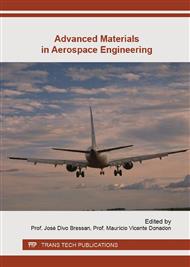[1]
Al-Khudairi, O., 2015. Characterising mode I/mode II fatigue delamination growth in unidirectional fibre reinforced polymer laminates,. Materials and Design, Vol. 66, pp.93-102.
DOI: 10.1016/j.matdes.2014.10.038
Google Scholar
[2]
Coronado, P. et al., 2014, Influence of low temperatures on the phenomenon of delamination of mode I fracture in carbon-fiber/epoxy composites under fatigue loading,. Composite Structures, Vol. 112, pp.188-193.
DOI: 10.1016/j.compstruct.2014.02.007
Google Scholar
[3]
Gibson, R.F. Principles of Composite Material Mechanics. Singapore: McGraw-Hill Book Co, (1994).
Google Scholar
[4]
Ramanujam, N., Vaddadi, P., Nakamura, T., Singh, R.P., 2008. Interlaminar fatigue crack growth of cross-ply composites under thermal cycles,. Composite Structures, Vol. 85, pp.175-187.
DOI: 10.1016/j.compstruct.2007.10.018
Google Scholar
[5]
Turon, A. et al., 2007. Simulaton of delamination in composites under high-cycle fatigue,. Composites: Part A, Vol. 38, pp.2270-2282.
DOI: 10.1016/j.compositesa.2006.11.009
Google Scholar
[6]
Figiel, L., Kaminski, M., 2003, Mechanical and thermal fatigue delamination of curved layered composites,. Computers and Structures, Vol. 81, pp.1865-1873.
DOI: 10.1016/s0045-7949(03)00207-4
Google Scholar
[7]
Sjögren, A.; Asp, L.E., 2002. Effects of temperature on delamination growth in a carbon/epoxy composite under fatigue loading,. InternationalJournalof Fatigue, Vol. 24, pp.179-184.
DOI: 10.1016/s0142-1123(01)00071-8
Google Scholar
[8]
Shokrieh, M.M., Kamali, S.M., 2005. Theoretical and experimental studies on residual stresses in laminated polymer composites,. JournalofCompositeMaterials, Vol. 39, pp.2213-2225.
DOI: 10.1177/0021998305053511
Google Scholar
[9]
Palerosi, A. C. Avaliação do comportamento termomecânico de laminados em material compósito por processamento digital de imagens. DoctoralThesis, ITA, São José dos Campos (2006).
DOI: 10.5016/dt000623501
Google Scholar
[10]
Cowley, K. D., Beaumont, P.W.R., 1997. The measurement and prediction of residual stresses in carbon-fiber/polymer composites,. Comp. Sci. and Technol., Vol. 57, pp.1445-1455.
DOI: 10.1016/s0266-3538(97)00048-1
Google Scholar
[11]
ABAQUS. Analysis User's Manual: Versão 6. 10-1. Providence: ABAQUS, (2010).
Google Scholar
[12]
Hahn, H. T., 1976. Residual stresses in polymer matrix composite laminates,. Journal of Composite Materials, Vol. 10, pp.266-278.
DOI: 10.1177/002199837601000401
Google Scholar
[13]
Daniel I.M., Ishai O. Engineering mechanics of composite materials. 2nded. New York: Oxford University Press; (2006).
Google Scholar
[14]
Shindo, Y., Inamoto, A., Narita, F.H., Horiguchi, K., 2006. Mode I fatigue delamination growth in GFRP woven laminates at low temperatures,. Engineering Fracture Mechanics, Vol. 73, p.2080-(2090).
DOI: 10.1016/j.engfracmech.2006.03.015
Google Scholar
[15]
Coronado, P., Argüelles, A., Viña, J., Viña, I., 2014. Influence of low temperatures on the phenomenon of delamination of mode I fracture in carbon-fiber/epoxy composites under fatigue loading,. Composite Structures, Vol. 112, pp.188-193.
DOI: 10.1016/j.compstruct.2014.02.007
Google Scholar
[16]
Yao, L., Alderliesten, R. C.; Zhao, M.; Benedictus, R., 2014. Discussion on the use of the strain energy release rate for fatigue delamination characterization,. Composites: Part A, Vol. 66, pp.65-72.
DOI: 10.1016/j.compositesa.2014.06.018
Google Scholar
[17]
Rans, C., Alderliesten, R., Benedictus, R., 2011. Misinterpreting the results: How similitude can improve our understanding of fatigue delamination growth,. Comp. Sci. and Technol., Vol. 71, p.230–238.
DOI: 10.1016/j.compscitech.2010.11.010
Google Scholar
[18]
Yokozeki, T.; Aoki, T.; Ishikawa, T., 2002. Fatigue growth of matrix cracks in the transverse direction of CFRP laminates,. Comp, Sci, and Technol., Vol. 62, pp.1223-1229.
DOI: 10.1016/s0266-3538(02)00068-4
Google Scholar
[19]
Endo, B.L.R.D., Caracterização da tenacidade à fratura interlaminar de um material compósito de fibra de carbono-epoxi considerando influência termomecânica. Master Dissertation, ITA, São José dos Campos (2014).
Google Scholar
[20]
Hexcel Composites. Hexply 8552 epoxy matriz (180 oC /356 oF curing matrix): product data. Publication FTA 072e, 2013. Available in: May 21th , (2014).
Google Scholar
[21]
Matthews, C., 2001. Aeronautical engineer's data book. Massachusetts: Butterworth-Heinemann Title; (2001).
Google Scholar
[22]
Jones, R. M. Mechanics of Composite Materials. 2nded. Philadelphia: Taylor and Francis; (1999).
Google Scholar
[23]
Nairn, J. A. Matrix microcracking. In: Talreja R., editor. Damage mechanics of composite material (1999). Elsevier Science.
Google Scholar
[24]
ASTM D 5528 – 01. Standard Test Method for Mode I Interlaminar Fracture Toughness of Unidirectional Fiber-Reinforced Polymer Matrix Composites. West Conshohocken, (2007).
DOI: 10.1520/d5528-01r07e01
Google Scholar
[25]
Martin, R. H., Davidson B., Mode II fracture toughness evaluation using a four point bend end notched flexure test,. Proceeding of the 4th International Deformation and Fracture of Composite Conference, London UK, pp.243-252.
DOI: 10.1179/146580199101540565
Google Scholar


